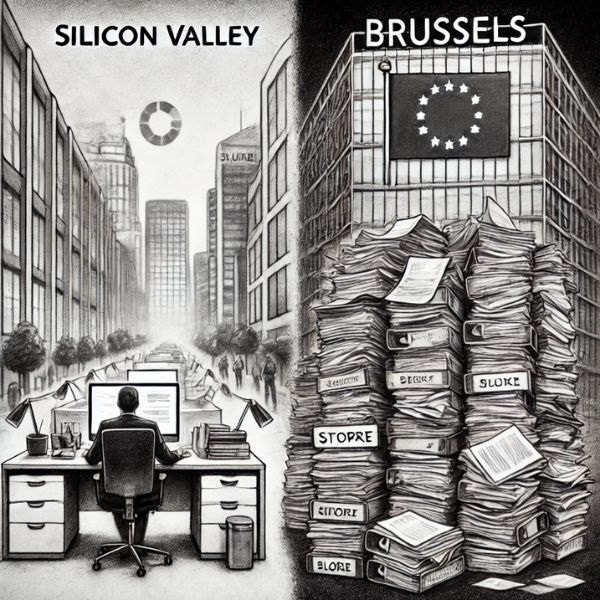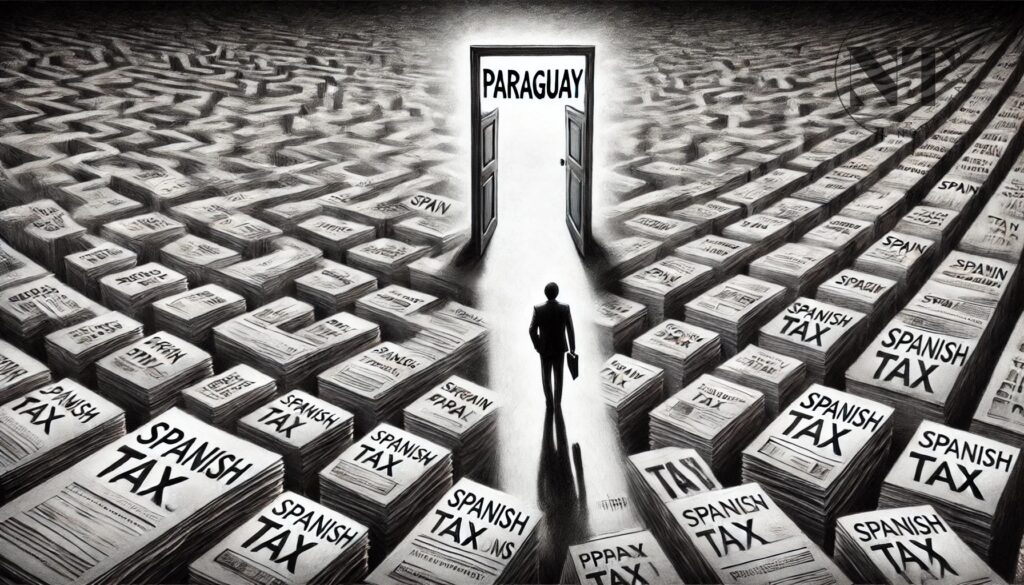You’re sitting on a terrace in Paris, enjoying a coffee as the city unfolds before you like a living postcard: cobbled streets, majestic architecture, the echo of a history that once shaped the world. But something feels off.
At the table next to you, two Asian tourists chat in English while pointing at a banner on the sidewalk. Their tone carries a mix of irony and disinterest. One of them chuckles and drops a brutal remark:
“Europe used to be the future… now it’s just a pretty museum to visit.”
And the harsh truth is undeniable. The Old Continent, once the epicenter of empires, revolutions, and innovation, has become a static stage, trapped in empty debates while the world moves forward without looking back.
Indice del artículo
From Global Power to Museum: The European Crisis in Numbers
While China builds entire cities in a matter of months, India emerges as a technological powerhouse, and the UAE attracts investment with competitive tax policies, Europe is busy regulating plastics and debating pronouns. While Elon Musk plans to colonize Mars and Jeff Bezos advances artificial intelligence, Brussels drowns in bureaucracy, suffocating any attempt at innovation.
What Happened to Europe?
The decline of Europe is not just economic or political. It is a mental, cultural, and social collapse. From conquerors to bureaucrats, from innovators to regulators, Europe has lost the hunger for greatness that once defined it. Instead, it has embraced a mindset of conformity, dependence on subsidies, and aversion to risk.
And here comes the key question:
Can this process be reversed, or are we witnessing the final sunset of an entire civilization?
The answers are not simple, but there are countries within Europe that resist decadence and have proven that a different path is possible. This blog will not only analyze the causes behind Europe’s decline but also highlight the solutions that some nations have successfully implemented.

From Global Power to a Living Museum: Europe’s Stagnation
To understand Europe’s decline, we must first remember what made it a global power in the first place.
This continent didn’t just dominate trade and exploration for centuries; it also revolutionized science, politics, and the global economy. From the Industrial Revolution to the Enlightenment, from great conquests to the development of modern democracy, Europe was the gold standard of the civilized world.
But something changed. The hunger for innovation and expansion faded, replaced by complacency.
Today, the great European metropolises—Paris, Rome, Berlin—are still spectacular, but their relevance is no longer the same. The center of global power has shifted.
While Europe drowns in bureaucracy and overregulation, Asia builds megacities in record time, and the U.S. continues to dominate technological innovation. The Old Continent seems more focused on preserving its past than shaping the future.
The signs of this stagnation are clear:
- Economic slowdown: The Eurozone is not growing at the pace of emerging economies.
- Brain drain: Young talent is seeking opportunities outside the continent.
- Loss of competitiveness: European companies cannot keep up with U.S. and Asian tech giants.
- Political and social decline: The European Union is more focused on ideological debates than on real growth strategies.
Europe no longer sets trends, no longer dictates the rules, no longer leads innovation. And the worst part? It doesn’t even seem to realize it.
What led Europe to this point? How did it go from dominating the world to becoming a continent that regulates more than it creates?
Innovation Moves to Asia and the U.S.: What Is Europe Doing Wrong?
While Europe gets lost in bureaucratic red tape, new powerhouses have taken the lead. For decades, the Old Continent was seen as the ideal model: stability, prosperity, innovation. But that balance has collapsed.
Today, when people talk about economic and technological growth, the cities that dominate the conversation are no longer Paris, London, or Berlin—but Beijing, New Delhi, and Dubai.
The numbers confirm it:
- China is the factory of the world and the epicenter of innovation in AI, e-commerce, and infrastructure.
- India is on its way to becoming the next great tech superpower, with a rapidly expanding digital market and a booming entrepreneurial middle class.
- The United Arab Emirates has turned a desert into a global business and investment magnet, offering more attractive tax and economic policies than any European country.
What do these countries have in common? Ambition, speed, and a clear vision for the future.
Europe, meanwhile, continues to debate regulations instead of revolutions.

China: From the World’s Factory to the Cutting Edge of Technology
Forty years ago, China was a developing country with moderate economic growth. Today, it is the world’s second-largest economy and a leader in innovation.
How Did China Achieve This?
✔ Massive investment in infrastructure: Entire cities built in months.
✔ Aggressive industrialization policies: Large-scale production and rapid technological expansion.
✔ Leadership in AI and 5G technology: Companies like Huawei and Tencent are at the forefront of the digital world.
✔ A gigantic domestic market: With over 1.4 billion people, its own consumption drives economic growth.
While China is developing maglev trains that reach 600 km/h, Europe is debating whether to ban diesel cars.
India: The New Tech Talent Powerhouse
If there is one country that could surpass China in the 21st century, it’s India.
This Asian giant has found the perfect formula for sustained growth:
✔ A young, highly skilled tech workforce.
✔ Startups challenging Silicon Valley’s dominance.
✔ A booming digital market, with over 700 million internet users.
✔ A rapidly improving business environment, with fewer regulatory barriers than Europe.
While Europe’s middle class stagnates and talent flees, India’s startups are growing at record speeds, creating new billionaires every year.
United Arab Emirates: How to Build an Empire in the Middle of the Desert
Just a few decades ago, Dubai and Abu Dhabi were nothing more than stretches of sand. Today, they are global financial hubs, business havens, and models of accelerated growth.
What Did They Do Right?
✔ Low taxes and ease of doing business.
✔ Attracting foreign investment with fiscal incentives.
✔ Massive infrastructure and technology projects without bureaucratic obstacles.
✔ A strategic vision to diversify the economy beyond oil.
While an entrepreneur in Europe spends months buried in paperwork just to open a business, in Dubai, it can be done in days.
Comparison: Europe vs. the New Global Powers
| Factor | Europe | China | India | UAE |
|---|---|---|---|---|
| GDP Growth | Stagnant (<2%) | 5-6% annually | 6-7% annually | 5-6% annually |
| Regulations | Excessive & restrictive | Flexible for technology | Constantly improving | Minimal for business |
| Innovation | Slow, hindered by red tape | Leader in AI & 5G | Emerging tech powerhouse | Global investment magnet |
| Tax Burden | High, discouraging growth | Competitive | Low for entrepreneurs | Almost nonexistent |
| Infrastructure | Outdated & costly | Rapid expansion | Strong development | Constant megaprojects |
The difference is clear: while Europe regulates and stagnates, emerging powers innovate and accelerate.
And here comes the big question: Can Europe learn from these countries, or is it doomed to fall behind forever?
Bureaucracy and Regulations: The Obstacles to Europe’s Economic Growth
Europe once led the world in scientific and technological revolutions—from Gutenberg’s printing press to the Industrial Revolution, from the rise of great universities to the first advances in telecommunications.
But today, what major innovation has Europe produced in the last few decades?
While Silicon Valley launches new industries and China dominates AI and telecommunications, Europe has lost its way. Entrepreneurs face an onslaught of regulations, taxes, and bureaucracy that suffocates any attempt at disruption.
Case Study: Tesla and the Failure of Europe’s Automotive Industry
One of the clearest examples of Europe’s failure to innovate is its automotive industry.
For decades, Europe dominated the car industry with legendary brands like BMW, Mercedes, Renault, and Volkswagen.
But when Tesla revolutionized electric vehicles, no European company was able to react in time.
Elon Musk bet on unrestrained innovation, and today, Tesla is worth more than all European automakers combined.
Meanwhile, Europe imposed environmental regulations that made things even harder for its own companies.
The Result?
✔ Tesla has taken over the electric car market, while Europe continues regulating its own decline.
✔ The most innovative mobility startups are being born in the U.S. and China—not in Europe.
✔ Musk has made it clear he prefers to invest anywhere but in the European Union.
If Europe couldn’t even innovate in its strongest industry, what hope is there for the rest?
Is There a Solution for Europe?
Is it too late for the Old Continent to regain relevance in innovation? Maybe not.
Some countries within Europe have proven that a different path is possible:
✔ Estonia has created an advanced digital ecosystem with almost no bureaucracy.
✔ Ireland has slashed taxes and become Europe’s tech hub.
✔ Countries like Cyprus and Malta have demonstrated that fewer regulations and more incentives drive economic growth.
The question is: Will Europe continue its descent into irrelevance, or will it finally take the bold steps needed to reclaim its place in global innovation?

Dependence and Subsidies: A Culture of Complacency
Europe’s problem is not just economic or political—it is a mindset.
Centuries ago, Europe was a continent of explorers, visionaries, and conquerors who crossed oceans without knowing what lay ahead. Today, it is a society where risk has become taboo, where the culture of effort has been replaced by a system of state dependency.
The state has shifted from being a regulator to the ultimate provider of economic stability, turning millions of citizens into dependents on subsidies, aid, and social benefits.
In theory, this model was meant to protect the most vulnerable, but in practice, it has become a brake on productivity and ambition.
- Unemployment benefits are no longer temporary support but a way of life for many.
- Inefficient companies do not disappear because the state bails them out with public money.
- Young people lack incentives to take business risks because the government guarantees a safety net that discourages private initiative.
In countries like the U.S. or China, success is celebrated. In Europe, it is punished with taxes and regulations.
The real issue is not the existence of subsidies but the deeply ingrained belief that prosperity is an unquestionable right, regardless of effort or productivity.
The Future of Europe: Is It Too Late to Regain Leadership?
Despite the challenges Europe faces, some countries have implemented successful policies to counteract the decline. These examples stand out for their focus on national sovereignty, economic competitiveness, and cultural identity.
Hungary and Poland: Defending National Sovereignty
Hungary and Poland have taken a firm stance in defense of their sovereignty, resisting external pressures to conform to EU policies they consider contrary to their national interests.
- Both countries prioritize border protection and the preservation of cultural and religious traditions.
- This approach has allowed them to maintain stricter control over their internal and economic policies, shielding them from external influence.
Estonia: Digital Innovation and Government Efficiency
Estonia has become a leader in digital governance and administrative efficiency.
- The country has implemented a fully digital government system, allowing citizens to complete most bureaucratic procedures online, cutting red tape and increasing transparency.
- Additionally, Estonia has cultivated a startup-friendly environment, attracting international investment and talent.
Ireland: Attractive Tax Policies and Economic Growth
Ireland has adopted a highly competitive fiscal policy, with a corporate tax rate of just 12.5%, attracting global tech giants.
- This strategy has generated jobs and sustained economic growth, positioning Ireland as a key European tech hub.
- The country has also invested heavily in education and workforce training to maintain its competitive edge.
Conclusion: Is Europe Beyond Saving, or Can It Still Wake Up?
Throughout this analysis, we have explored Europe’s decline from various angles: its loss of economic leadership, technological stagnation, suffocating bureaucracy, dependency on subsidies, and a crisis of values that has eroded its identity.
However, not all is lost. Countries like Hungary, Poland, Estonia, and Ireland have proven that decline is not inevitable—that sovereignty, innovation, and economic growth can thrive without outdated structures dragging them down.
Europe’s Future: Two Possible Paths
Europe stands at a historic crossroads. From here, it has two choices:
1. Continue the Spiral of Decline
- More bureaucracy, higher taxes, more regulations.
- Less innovation, less investment, less competitiveness.
- Greater dependence on the state, less private initiative.
- More censorship, less freedom of thought.
If this model persists, Europe will permanently lose its place in the world.
- Its best talent will continue to flee.
- Major companies will relocate to countries with greater economic flexibility.
- The European Union will become an irrelevant player on the global stage.
2. Regain Ambition and Return to Competition
- Cut bureaucracy and encourage entrepreneurship.
- Lower taxes and attract investment in key sectors.
- Prioritize education and innovation as engines of growth.
- Defend national sovereignty without external impositions.
- Restore values that promote effort, competition, and excellence.
This is not an easy path. It requires boldness, vision, and a break from the culture of complacency that has defined Europe in recent decades.
Will Europe Wake Up or Disappear?
The decision is not in the hands of politicians, Brussels, or bureaucrats.
It lies with the citizens—with those who still believe in a continent that can be relevant, competitive, and sovereign.
History has proven that no civilization is guaranteed to stay at the top.
Rome fell. Byzantium fell. European empires collapsed.
The question is: Will Europe allow itself to be erased from the map of global powers, or will it wake up before it’s too late?



